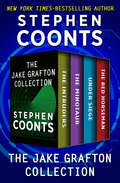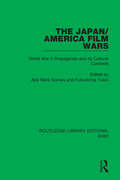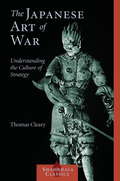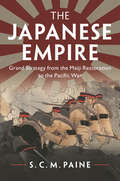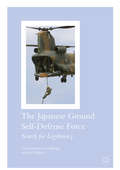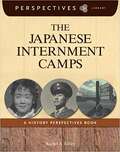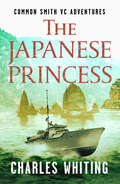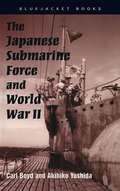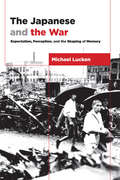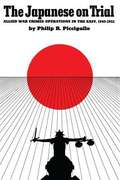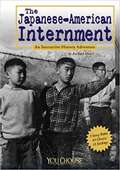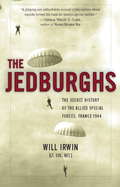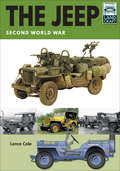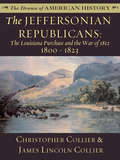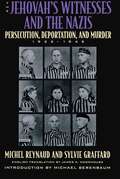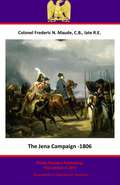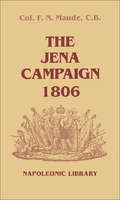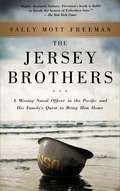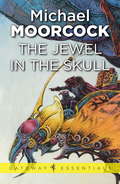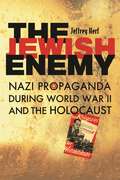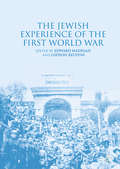- Table View
- List View
The Jake Grafton Collection: The Intruders, The Minotaur, Under Siege, and The Red Horseman (Jake Grafton)
by Stephen CoontsThe hero of the New York Times–bestselling Flight of the Intruder is back in action—&“Stephen Coonts, like Jake Grafton, just keeps getting better&” (Tom Clancy). Navy pilot Jake Grafton took the fight to the enemy in the Vietnam War, winning the Congressional Medal of Honor and becoming a legend in the military community. But now he must navigate life both in the cockpit and in the halls of power as he finds himself on the front lines of a new kind of war . . . The Intruders: In this sequel to Flight of the Intruder, Grafton is stationed in the South Pacific on the USS Columbia, where his new mission is to educate an unruly group of Marines in the art of flying from an aircraft carrier. They better be fast learners, because they&’ll have to work together to survive against an enemy unlike any they&’ve ever faced. &“In the realm of today&’s military fiction, Mr. Coonts&’s The Intruders is as good as they come.&” —The Dallas Morning News The Minotaur: Grafton is heading up a top-secret stealth bomber program at the Pentagon when a series of mysterious deaths occurs, leading him on a manhunt within the US government for a Soviet mole code-named the &“Minotaur.&” If he can&’t find the traitor, Grafton could lose far more than just his career . . . &“Wildly inventive.&” —Ocala Star-Banner Under Siege: In this New York Times bestseller, when a vicious drug lord is captured and brought to Washington, DC, for trial, his fanatically loyal private army prepares to launch an attack on the United States—and its president. The only man who can stop the bloodshed and take down the assassins is Jake Grafton. &“Will keep you glued to your seat on a roller-coaster ride of adventure.&” —USA Today The Red Horseman: As the USSR falls, newly appointed intelligence chief Jake Grafton knows that even as one threat falls, several more are waiting to get their hands on the former Soviet nuclear arsenal. And as he tries to stop a possible Armageddon, someone who is supposed to be on Grafton&’s side is working to make sure he fails. &“Quick-firing excitement, plot, and action . . . Coonts at his best.&” —The Dallas Morning News
The Japan/America Film Wars: World War II Propaganda and its Cultural Contexts (Routledge Library Editions: WW2 #15)
by Abé Mark Nornes and Fukushima YukioWith contributions from noted critics and film historians from both countries, this book, first published in 1994, examines some of the most innovative and disturbing propaganda ever created. It analyses the conflicting images of these films and their effectiveness in defining public perception of the enemy. It also offers pointed commentary on the power of visual imagery to enhance racial tensions and enforce both positive and negative stereotypes of the Other.
The Japanese Art of War: Understanding the Culture of Strategy
by Thomas ClearyMilitary rule and the martial tradition of the samurai dominated Japanese culture for more than eight hundred years. According to Thomas Cleary--translator of more than thirty-five classics of Asian philosophy--the Japanese people have been so steeped in the way of the warrior that some of the manners and mentality of this outlook remain embedded in their individual and collective consciousness. Cleary shows how well-known attributes such as the reserve and mystery of formal Japanese behavior are deeply rooted in the ancient strategies of the traditional arts of war. Citing original Japanese sources that are popular among Japanese readers today, he reveals the hidden forces behind Japanese attitudes and conduct in political, business, social, and personal life.
The Japanese Empire
by Paine S. C. M.The Japanese experience of war from the late-nineteenth to the mid-twentieth century presents a stunning example of the meteoric rise and shattering fall of a great power. As Japan modernized and became the one non-European great power, its leaders concluded that an empire on the Asian mainland required the containment of Russia. Japan won the First Sino-Japanese War (1894-5) and the Russo-Japanese War (1904-5) but became overextended in the Second Sino-Japanese War (1931-45), which escalated, with profound consequences, into World War II. A combination of incomplete institution building, an increasingly lethal international environment, a skewed balance between civil and military authority, and a misunderstanding of geopolitics explains these divergent outcomes. This analytical survey examines themes including the development of Japanese institutions, diversity of opinion within the government, domestic politics, Japanese foreign policy and China's anti-Japanese responses. It is an essential guide for those interested in history, politics and international relations.
The Japanese Ground Self-Defense Force
by Paul Midford Robert D. EldridgeBased on extensive Japanese-language materials, this book is the first to examine the development of Japan's Ground Self-Defense Force. It addresses: how the GSDF was able to emerge as the post-war successor of the Imperial Japanese Army despite Japan's anti-militarist constitution; how the GSDF, despite the public skepticism and even hostility that greeted its creation, built domestic and international legitimacy; and how the GSDF has responded to changes in international and domestic environments. This path-breaking study of the world's third-largest-economic power's ground army is timely for two reasons. First, the resurgence of tensions in Northeast Asia over territorial disputes, and the emphasis recent Japanese governments have placed on using the GSDF for defending Japan's outlying islands is driving media coverage and specialist interest in the GSDF. Second, the March 11, 2011 Great East Japan Earthquake and Tsunami has focused global attention on the GSDF as Japan's lead disaster relief organization. This highly informative and thoroughly researched book provides insight for policy makers and academics interested in Japanese foreign and defense policies.
The Japanese Internment Camps: A History Perspectives Book (Perspectives Library)
by Rachel A. BaileyThis book relays the factual details of the Japanese internment camps in the United States during World War II. The narrative provides multiple accounts of the event, and readers learn details through the point of view of a child at an internment camp, a Japanese-American soldier, and a worker at the Manzanar War Relocation Center. The text offers opportunities to compare and contrast various perspectives in the text while gathering and analyzing information about a historical event.
The Japanese Princess (Common Smith VC Adventures)
by Charles WhitingA kidnapped princess sends Common Smith racing to the land of the rising sunChina, 1927. Communists and Nationalists are fighting each other, and bandits and warlords plague the country. Imperial Japan is eager to provoke a war, and when Princess Sadie, a member of the Japanese royal family, is kidnapped, her life is at stake. For if she dies, the Japanese will have the excuse they need to invade.The mission of Common Smith VC and the redoubtable crew of the Swordfish is to rescue Princess Sadie and avert calamity. It is a race against time - if they don't succeed, the results could be devastating...The sixth Common Smith VC adventure, where both tensions and the stakes couldn't be higher. Perfect for fans of Max Hennessy and David Beaty.
The Japanese Submarine Force and World War II
by Akihiko Yoshida Yoshida Carl BoydWhen first published in 1995, this book was hailed as an absolutely indispensable contribution to the history of the Pacific War. Drawing heavily from Japanese sources and American wartime intercepts of secret Japanese radio messages, a noted American naval historian and a Japanese mariner painstakingly recorded and evaluated a diverse array of material about Japan's submarines in World War II.The study begins with the development of the first Japanese 103-ton Holland-type submergible craft in 1905 and continues through the 1945 surrender of the largest submarine in the world at the time, the 5300-ton I-400 class that carried three airplanes. Submarine weapons, equipment, personnel, and shore support systems are discussed first in the context of Japanese naval preparations for war and later during the war. Both successes and missed opportunities are analyzed in operations ranging from the California coast through the Pacific and Indian Oceans to the coast of German-occupied France. Appendixes include lists of Japanese submarine losses and the biographies of key Japanese submarine officers. Rare illustrations and specifically commissioned operational maps enhance the text.
The Japanese and the War: Expectation, Perception, and the Shaping of Memory (Asia Perspectives: History, Society, and Culture)
by Michael LuckenMemories of World War II exert a powerful influence over Japan's culture and society. In The Japanese and the War, Michael Lucken details how World War II manifested in the literature, art, film, funerary practices, and education reform of the time. Concentrating on the years immediately before and after (1937 to 1952), Lucken explores the creation of an idea of Japanese identity that still resonates in everything from soap operas to the response to the Fukushima nuclear disaster.Lucken defines three distinct layers of Japan's memory of World War II: the population's expectations at the beginning, the trauma caused by conflict and defeat, and the politics of memory that arose after Japan lost to the Allied powers. Emphasizing Japanese-language sources, Lucken writes a narrative of the making of Japanese cultural memory that moves away from Western historical modes and perspectives. His approach also paints a new portrait of the U.S. occupation, while still maintaining a cultural focus. Lucken sets out to capture the many ways people engage with war, but particularly the full range of Japan's experiences, which, he argues, the Japanese state has yet to fully confront, leading to a range of tensions at home and abroad.
The Japanese on Trial: Allied War Crimes Operations in the East, 1945-1951
by Philip R. PiccigalloThis comprehensive treatment of post-World War II Allied war crimes trials in the Far East is a significant contribution to a neglected subject. While the Nuremberg and, to a lesser degree, Tokyo tribunals have received considerable attention, this is the first full-length assessment of the entire Far East operation, which involved some 5,700 accused and 2,200 trials. After discussing the Tokyo trial, Piccigallo systematically examines the operations of each Allied nation, documenting procedure and machinery as well as the details of actual trials (including hitherto unpublished photographs) and ending with a statistical summary of cases. This study allows a completely new assessment of the Far East proceedings: with a few exceptions, the trials were carefully and fairly conducted, the efforts of defense counsel and the elaborate review procedures being especially noteworthy. Piccigallo's approach to this emotion-filled subject is straightforward and evenhanded throughout. He concludes with a discussion of the broader implications of such war crimes trials, a matter of interest to the general reader as well as to specialists in history, law, and international affairs.
The Japanese-American Internment: An Interactive History Adventure (Understanding Differences Series)
by Lola M. Schaefer Rachael HanelDescribes the events surrounding the internment of Japanese Americans in relocation centers during World War II. <P><P>The reader's choices reveal the historical details from the perspective of Japanese internees and Caucasians.
The Jazz Club Spy
by Roberta RichA riveting historical thriller about a Jewish cigarette girl in 1930s New York who finds the soldier who burned down her Russian village years earlier only to be swept up in a political conspiracy on the eve of World War II—from the #1 bestselling author of The Midwife of Venice.New York, 1939 Giddy Brodsky knows she&’s lucky to have a job as a cigarette girl at a Manhattan jazz club, but she dreams of opening her own beauty shop and lifting her family out of poverty. The Brodskys have lived cheek to jowl in the Lower East Side tenements since they came to America nineteen years ago, fleeing a deadly pogrom in their Russian village. But they continue to face prejudice, especially with the rise of the fascist organization the American Bund. Yet Giddy is focused on the future—until she recognizes one of the Cossacks who irrevocably changed her life and the past comes flooding back. Determined to get justice, she enlists the help of Carter van der Zalm, a regular at the jazz club who also happens to be the director with the Department of Immigration at Ellis Island. When Carter discloses that the Cossack is an &“undesirable&” and may be of interest to the government, Giddy agrees to moonlight as a spy for him. Not everyone is who they appear to be, and after a shocking betrayal, Giddy finds herself embroiled in a political conspiracy that could bring America into the war in Europe. From the gritty tenements to the glittering jazz clubs of 1930s New York, The Jazz Club Spy is a thrilling historical novel about a brash young woman who must use all her wits to save the ones she loves.
The Jazz Club Spy
by Roberta RichFrom the author of the &“riveting&” (Chicago Tribune) The Midwife of Venice, a fresh and sweeping historical novel following a Jewish woman attempting to bring justice to her family on the eve of World War II.New York City, 1939: At the height of the Great Depression, a time when President Roosevelt is trying to keep America out of World War II, Giddy Brodsky is lucky to have a job as a cigarette girl at a Manhattan jazz club. Nevertheless, she dreams of establishing a cosmetics business and leaving the poverty-stricken Lower East Side tenements behind. She has lived there with her family ever since they fled Russia, forced to emigrate after a group of Cossacks burned down their village, and her memories continue to haunt her. Giddy tries to focus on the future until, during an evening streetcar ride, she thinks she recognizes one of the Cossacks who changed her life forever. Determined to get answers, she enlists the help of Carter van der Zalm, the Chief Commissioner of Immigration at Ellis Island, who is hunting the same man. He suspects the Russian is involved in an assassination plot that will destroy American and Soviet relations, and he enlists Giddy to moonlight as a spy for him. But when she finally tracks down the man they&’re both seeking, she finds herself in the middle of a shocking political conspiracy that changes everything she once held true. In the tradition of Lara Prescott&’s The Secrets We Kept and Kate Quinn&’s The Rose Code, The Jazz Club Spy is a glittering and gritty look at pre-WWII America, and the personal battle one woman wages between justice and forgiveness.
The Jedburghs: The Secret History of the Allied Special Forces, France 1944
by Will IrwinThe first full history of the pioneering Special Forces units of World War II - dropped behind German lines into France to assist with the D-Day landings - told by a former U. S. Special Forces colonel with unique access to surviving veteransThe story of the Special Forces in World War II has never fully been told before. Information about them began to be declassified only in the 1980s. Known as the Jedburghs, these Special Forces were selected from members of the British, American, and Free French armies to be dropped in teams of three deep behind German lines. There, in preparation for D-Day, they carried out what we now know as unconventional warfare: supporting the French Resistance in guerrilla attacks, supply-route disruption, and the harassment and obstruction of German reinforcements. Always, they operated against extraordinary odds. They had to be prepared to survive pitched battles with German troops and Gestapo manhunts for weeks and months while awaiting the arrival of Allied ground forces. They were, in short, heroes. The Jedburghs finally tells their story and offers a new perspective on D-Day itself. Will Irwin has selected seven of the Jedburgh teams and told their stories as gripping personal narratives. He has gathered archival documents, diaries, and correspondence, and interviewed Jed veterans and family members in order to present this portrait of their crucial role - a role recognized by Churchill and Eisenhower - in the struggle to liberate Europe in 1944-45.
The Jeep: Second World War (LandCraft)
by Lance Cole&“The Jeep is as iconic a military vehicle as the Chieftain tank, and this terrific book celebrates it in brilliant style . . . inspiring.&” —Books Monthly The Second World War Jeep was one of the most famous and influential military vehicles of all time, and over 600,000 were produced. It served with all the Allied forces during the war on every front and it has been the inspiration behind the design of light, versatile, rugged military and civilian vehicles ever since. In this, the first volume in Pen & Sword&’s LandCraft series, Lance Cole traces the design, development and manufacturing history of the Jeep and describes its operational role within the Allied armies. A selection of archive photographs showing the Jeep in service in European and Pacific campaigns gives a graphic impression of how adaptable the Jeep was and records the variety of equipment it could carry. The book is an excellent source for the modeler, providing details of available kits, together with specially commissioned color profiles recording how the Jeeps used by different units and armies appeared. Lance Cole&’s introduction to the Jeep is necessary reading and reference for enthusiasts and modelers. &“If you are a modeler looking for guidance and inspiration then this book is a must have. Its pages are packed full of jeep goodness, giving tips and ideas for your build. It is also a great read, or coffee-time browser, if you are a vehicle enthusiast or simply love Willys/Ford jeeps and merely want to stimulate your brain and satisfy your eyes.&” —The OCAD Collection
The Jeffersonian Republicans: 1800 - 1823
by James Lincoln Collier Christopher CollierHistory is dramatic -- and the renowned, award-winning authors Christopher Collier and James Lincoln Collier demonstrate this in a compelling series aimed at young readers. Covering American history from the founding of Jamestown through present day, these volumes explore far beyond the dates and events of a historical chronicle to present a moving illumination of the ideas, opinions, attitudes and tribulations that led to the birth of this great nation. The Jeffersonian Republicans examines various events between 1800 and 1823 that helped to shape the United States. The Louisiana Purchase, the War of 1812, and important Supreme Court decisions are among the discussed events. The text is enhanced with images of art & artifacts, maps, and photographs of historic significance.
The Jehovah's Witnesses and the Nazis: Persecution, Deportation, and Murder, 1933-1945
by Michel Reynaud Sylvie GraffardThe Jehovah's Witnesses endured intense persecution under the Nazi regime, from 1933 to 1945. Unlike the Jews and others persecuted and killed by virtue of their birth, Jehovah's Witnesses had the opportunity to escape persecution and personal harm by renouncing their religious beliefs. The vast majority refused and throughout their struggle, continued to meet, preach, and distribute literature. In the face of torture, maltreatment in concentration camps, and sometimes execution, this unique group won the respect of many contemporaries. Up until now, little has been known of their particular persecution.
The Jena Campaign - 1806 (The Special Campaigns Series #9)
by Colonel Frederic Natusch Maude, C.B., late R.E.This ebook is purpose built and is proof-read and re-type set from the original to provide an outstanding experience of reflowing text for an ebook reader. Prussia had sat on the sidelines in 1805 whilst Napoleon hammered the Austrian and Russian armies in a dazzling series of victories culminating at the battle of Austerlitz. As the court of Frederick William III awaited a favourable moment to intervene, they looked on their army with a misplaced confidence based on the deeds of Frederick the Great, his well-drilled infantry and daring cavalry. However, the army had not kept up with the development of the French: their training suffered the constraints of financial cut-backs, their leaders were divided, vain, egocentric, incompetent or just too plain old. Frederick William was determined to cross swords with Napoleon, using a violation of territory by the French the year before as a pretext he started to mobilise his troops. His opponent was at the height of his military power. Although he did not really want to have another war so soon after crushing Austria, Napoleon was not the sort of man to back down from a challenge from the Prussians. As the troops readied themselves for the upcoming war, the Prussian generals vacilitated, abrogated responsibility, argued and split their forces. Napoleon organised his men into three mutually supporting columns as he invaded Prussian territory, unable to divine the intentions of his opponents. He was ready for all situations. Napoleon with his main army faced a sizeable portion of the Prussian forces at Jena, whilst Davout, perhaps his best subordinate, stood outnumbered but unshaken at Auerstädt. The fighting was brutal, short and bloody and would lead to Prussia being humbled for years to come, seething for revenge. This book formed part of the Special Campaigns series, which was written in the early years at the turn of the twentieth century to provide detailed assessments of the historic campaigns of the past for the benefit of the officers of the British Army. They were all written by current or recently retired officers of the Army who shared their wealth of experience and insight to a new generation, each officer having had a specialist area of expertise. Colonel Maude was an authority on the campaigns of Napoleon, and wrote three volumes for the series, the others focussing on the 1805 and 1813 campaigns. He describes the campaign in brilliant vivid detail, using material from the official archives of both France and Prussia as well as numerous eye-witness details. A fascinating book in an excellent series. Author - Colonel Frederic Natusch Maude, C.B., late R.E. (1854-1933) Text taken, whole and complete, from the edition published in 1909, London, by Swan Sonnenschein Original - 202 pages. Illustrations - 5 Maps and Diagrams, 4 A3 maps have been omitted due to their size. Linked TOC
The Jena Campaign, 1806: 1806-the Twin Battles Of Jena And Auerstadt Between Napoleon's French And The Prussian Army (The Napoleonic Library #Vol. 33)
by F. N. MaudeIn this balanced and gripping narrative of t he Jena Campaign, Maude gives the reader an insight into the strengths and weaknesses of the 2 opposing armies. With the diagrams that show the 2 sides'' positions, the battle can b e followed with ease.
The Jersey Brothers: A Missing Naval Officer in the Pacific and His Family's Quest to Bring Him Home
by Sally Mott FreemanThe extraordinary, real-life adventure of three brothers at the center of the most dramatic turning points of World War II and their mad race to change history—and save one of their own.They are three brothers, all Navy men, who end up coincidentally and extraordinarily at the epicenter of three of the war’s most crucial moments. Bill is picked by Roosevelt to run his first Map Room in Washington. Benny is the gunnery and anti-aircraft officer on the USS Enterprise, one of the only carriers to escape Pearl Harbor and by the end of 1942 the last one left in the Pacific to defend against the Japanese. Barton, the youngest and least distinguished of the three, is shuffled off to the Navy Supply Corps because his mother wants him out of harm’s way. But this protection plan backfires when Barton is sent to the Philippines and listed as missing-in-action after a Japanese attack. Now it is up to Bill and Benny to find and rescue him. Based on ten years of research drawn from archives around the world, interviews with fellow shipmates and POWs, and primary sources including diaries, unpublished memoirs, and letters half-forgotten in basements, The Jersey Brothers is a remarkable story of agony and triumph—from the home front to Roosevelt’s White House, and Pearl Harbor to Midway and Bataan. It is the story, written with intimate, novelistic detail, of an ordinary young man who shows extraordinary courage as the Japanese do everything short of killing him. And it is, above all, a story of brotherly love: of three men finding their loyalty to each other tested under the tortures of war—and knowing that their success or failure to save their youngest brother will shape their family forever.
The Jewel In The Skull (Gateway Essentials #446)
by Michael MoorcockDorian Hawkmoon, the last Duke of Koln, swore to destroy the Dark Empire of Granbretan. But after his defeat and capture at the hands of the vast forces of the Empire, Hawkmoon becomes a puppet, co-opted by his arch nemesis, the ruthless Baron Meliadus, to infiltrate the last stronghold of rebellion against Granbretan: the small but powerful city of the Kamarg. He has been implanted with a black jewel, through which the Dark Empire can control his every decision. But in the stronghold of the Kamarg, Hawkmoon discovers the power inside him to overcome any control, and his vengeance against the Dark Empire is filled with an unrelenting fury.
The Jewel and the Key
by Louise SpieglerAn earthquake and the discovery of a mysterious antique mirror unleash forces that jolt sixteen-year-old Addie McNeal back to 1917 Seattle, just as the United States is entering World War I. Addie finds herself shuttling back and forth between past and present, drawn in both times to the grand Jewel Theater. In both decades the existence of the Jewel is threatened and war is looming . . . and someone she cares about is determined to fight. Eventually, Addie realizes that only she has the key to saving the Jewel--and the lives of her friends. But will she figure out how to manipulate the intricately woven threads of time and truly set things right?
The Jewish Emergence from Powerlessness
by Yehuda BauerThe theme of this book is the gradual emergence of the Jewish people from total political powerlessness - a development stretching over nearly 100 years and culminating in the consolidation in the State of Israel. Ironically, Professor Bauer demonstrates, events during this period stemmed in part from a belief in the power of the international Jewish community that never existed - but that motivated both the Germans and, after the war, the British.This is a brief but absorbing study by one of the world's great experts on the Holocaust, who has drawn on a huge body of material to depict one of the unforgettable events in recent history from an arresting and unfamiliar point of view.
The Jewish Enemy: Nazi Propaganda during World War II and the Holocaust
by Jeffrey Herf<p>The sheer magnitude of the Holocaust has commanded our attention for the past sixty years. The extent of atrocities, however, has overshadowed the calculus Nazis used to justify their deeds. <p>According to German wartime media, it was German citizens who were targeted for extinction by a vast international conspiracy. Leading the assault was an insidious, belligerent Jewish clique, so crafty and powerful that it managed to manipulate the actions of Roosevelt, Churchill, and Stalin. Hitler portrayed the Holocaust as a defensive act, a necessary move to destroy the Jews before they destroyed Germany. <p>Joseph Goebbels, Minister of Propaganda, and Otto Dietrich’s Press Office translated this fanatical vision into a coherent cautionary narrative, which the Nazi propaganda machine disseminated into the recesses of everyday life. Calling on impressive archival research, Jeffrey Herf recreates the wall posters that Germans saw while waiting for the streetcar, the radio speeches they heard at home or on the street, the headlines that blared from newsstands. The Jewish Enemy is the first extensive study of how anti-Semitism pervaded and shaped Nazi propaganda during World War II and the Holocaust, and how it pulled together the diverse elements of a delusionary Nazi worldview. Here we find an original and haunting exposition of the ways in which Hitler legitimized war and genocide to his own people, as necessary to destroy an allegedly omnipotent Jewish foe. In an era when both anti-Semitism and conspiracy theories continue to influence world politics, Herf offers a timely reminder of their dangers along with a fresh interpretation of the paranoia underlying the ideology of the Third Reich.</p>
The Jewish Experience of the First World War
by Edward Madigan Gideon ReuveniThis book explores the variety of social and political phenomena that combined to the make the First World War a key turning point in the Jewish experience of the twentieth century. Just decades after the experience of intense persecution and struggle for recognition that marked the end of the nineteenth century, Jewish men and women across the globe found themselves drawn into a conflict of unprecedented violence and destruction. The frenzied military, social, and cultural mobilisation of European societies between 1914 and 1918, along with the outbreak of revolution in Russia and the collapse of the Ottoman Empire in the Middle East had a profound impact on Jewish communities worldwide. The First World War thus constitutes a seminal but surprisingly under-researched moment in the evolution of modern Jewish history. The essays gathered together in this ground-breaking volume explore the ways in which Jewish communities across Europe and the wider world experienced, interpreted and remembered the ‘war to end all wars’.
